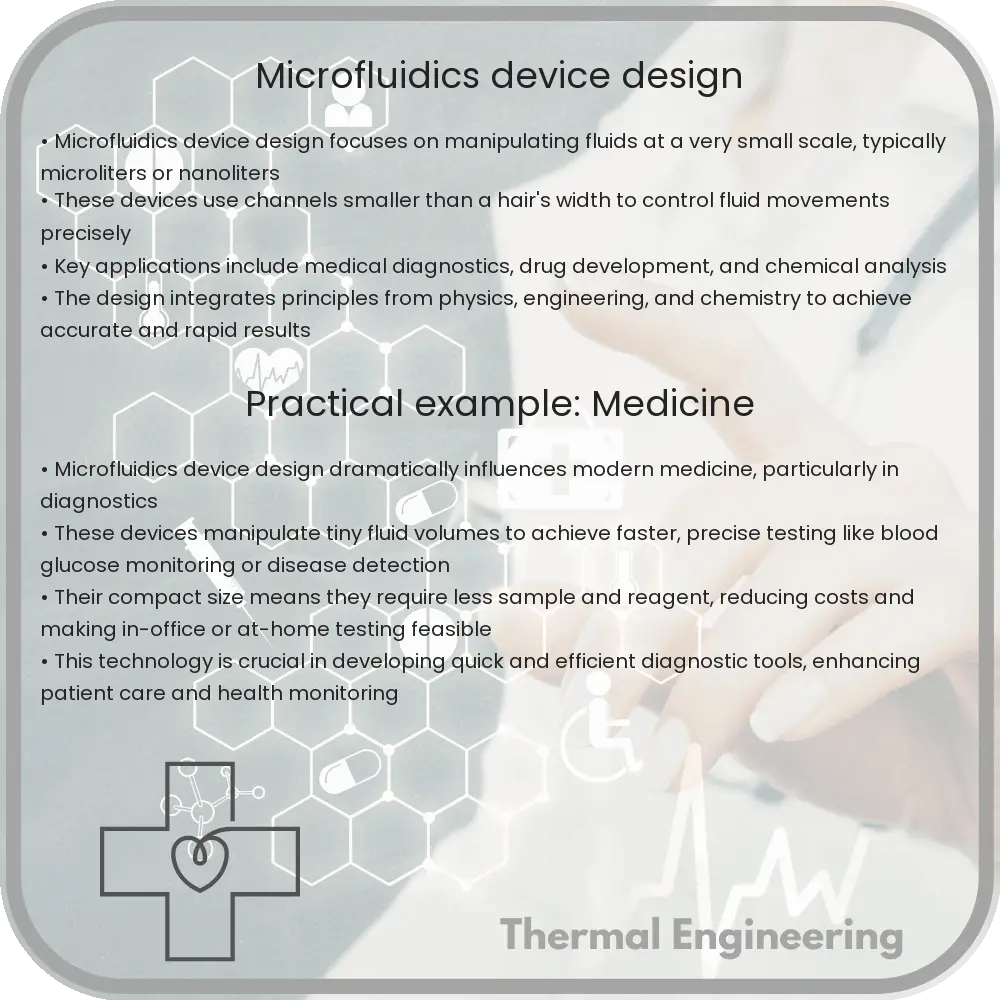Understanding the design and application of microfluidic devices in manipulating small fluid volumes.

Introduction to Microfluidics Device Design
Microfluidics is the science and technology of systems that process or manipulate small (<1 microliter) amounts of fluids, using channels with dimensions of tens to hundreds of micrometers. It is a multidisciplinary field intersecting engineering, physics, chemistry, and biotechnology. Microfluidic devices are used in a wide range of applications, including medical diagnostics, drug delivery, and chemical analysis.
The Basics of Microfluidic Device Design
Designing a microfluidic device involves understanding the fundamentals of fluid mechanics at the microscale, where the behavior of fluids can be significantly different from macroscopic systems. One crucial factor at this scale is that the flow is typically laminar, meaning that the fluid flows in parallel layers with minimal mixing. This is quantified by the Reynolds number, which is calculated by:
Re = ρ*u*L/μ
- ρ (rho) represents the density of the fluid,
- u is the flow velocity,
- L denotes a characteristic length (typically the channel dimension), and
- μ (mu) is the dynamic viscosity of the fluid.
In microfluidic applications, the Reynolds number is often less than 2000, ensuring laminar flow. This has implications for device design, including predictability of fluid flow and enhanced control over fluid mixing using diffusion.
Materials and Fabrication Techniques
Microfluidic devices are typically made from silicon, glass, or polymers like PDMS (polydimethylsiloxane). The choice of material can depend on factors such as chemical compatibility, optical transparency, and mechanical properties. Fabrication techniques include:
- Soft lithography: Often used for PDMS devices, involving a process of creating molds which are then used to cast the microfluidic channels.
- Photolithography: This technique is similar to that used in microelectronics. A light-sensitive polymer is exposed to UV light through a mask, defining microscale features.
- Injection molding: Suitable for mass production, used primarily with thermoplastics.
Integration and Control
Integrating different functionalities into a microfluidic device often includes incorporating sensors, mixers, pumps, and valves. Each component must be designed to operate effectively at the microscale. Controlling fluid flow can be achieved using various actuation methods such as:
- Electrokinetic methods: Involving electro-osmosis or electrophoresis.
- Pneumatic control: Using air pressure to manipulate fluids, especially in PDMS devices.
- Capillary forces: Utilized for passive fluid control without the need for external power sources.
Challenges and Future Directions
Despite the many advantages of microfluidic devices, there are challenges that need to be addressed, such as minimizing the effects of surface tension, which can be dominant at small scales, and dealing with issues of clogging. Furthermore, the integration of these devices with electronics and data processing systems for automated analysis remains an area of active development.
Looking forward, advancements in 3D printing and nanofabrication hold promise for the future of microfluidics by allowing more complex geometries and multi-material devices. These developments could further expand the applications of microfluidics in various fields, pushing the boundaries of what can be tested and processed on a microscale.
Microfluidics is a vibrant field of study that combines engineering, chemistry, and biology to create innovative solutions for complex problems. Its continued evolution will undoubtedly contribute significantly to science and technology.